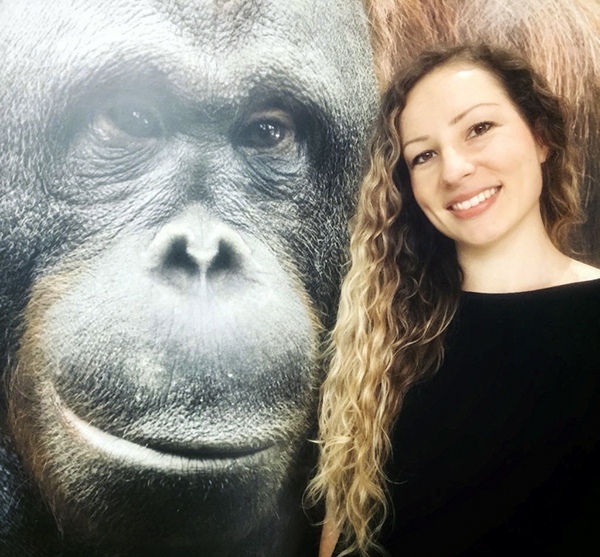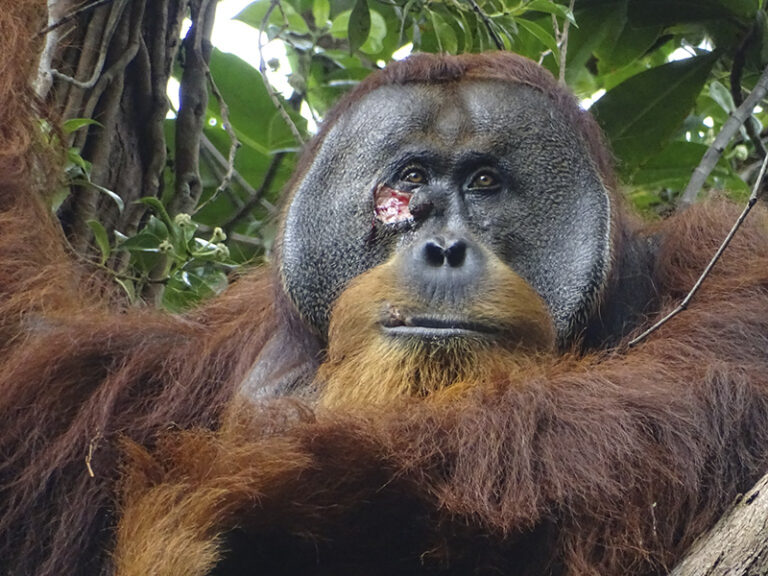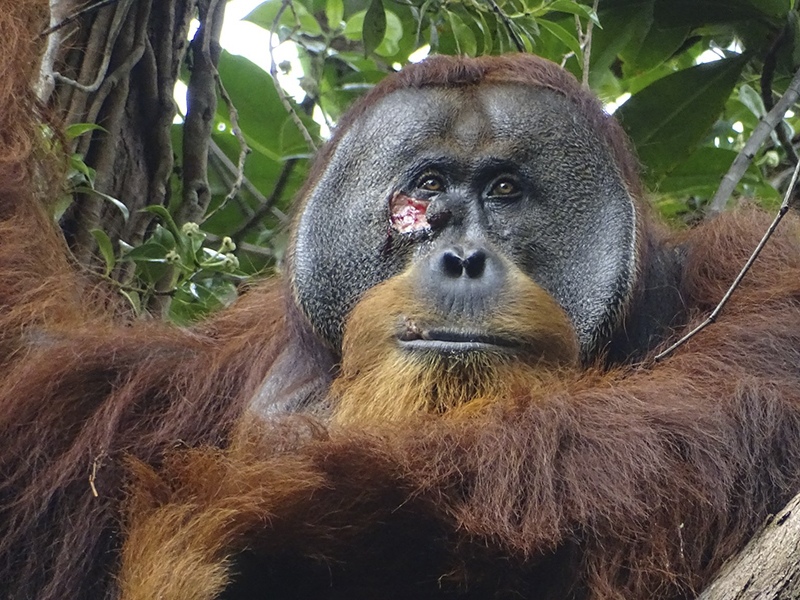
Groundbreaking Discovery: Orangutan Uses Medicinal Plant for Wound Treatment
Recently, biologists from the Max Planck Institute of Animal Behavior and Universitas Nasional in Indonesia made a groundbreaking observation: a wild animal was seen treating its wounds with a medicinal plant for the first time. This behavior was recorded in a male Sumatran orangutan, who used the sap of a climbing plant known for its anti-inflammatory and pain-relieving properties to treat a facial injury. This discovery suggests that the use of medicinal plants in wound care might have ancient evolutionary origins.
In a study published in Scientific Reports, cognitive and evolutionary biologists reported evidence of active wound treatment with a healing plant in a wild male Sumatran orangutan. The study, led by Dr. Caroline Schuppli and Dr. Isabelle Laumer at the Suaq Balimbing research site in Indonesia, found that Rakus, the male orangutan, applied chewed leaves of the Fibraurea tinctoria plant to his wound. This plant is traditionally used in Southeast Asian medicine for its healing properties. The findings suggest that Rakus’s behavior was deliberate and focused, highlighting the complex cognitive abilities of orangutans and their capacity for problem-solving. This prompts further investigation into the evolutionary roots of medicinal plant use in humans and other great apes.
The following Q&A with Dr. Isabelle Laumer provides more detailed explanations and the implications of their findings.

Q: Your study highlights that Rakus not only applied the plant sap to his wound but also covered it with chewed leaves. Can you tell us how you started this research and why?
A: The research at this site has been ongoing since 1994. The area is a peat swamp forest home to around 150 critically endangered Sumatran orangutans. It was founded by Professor Dr. Carl van Schaik, who was looking for a site to study these orangutans. He discovered that the orangutans in this area were quite social, largely due to the high fruit availability and well-established hierarchies. This means we observe fewer fights and wounds among them. The site is not a sanctuary but a wild forest where the orangutans live freely.
The females generally stay within the area, while the males disperse during or after puberty to establish new territories. Rakus, for example, was not born in Suaq. He was first observed in 2009 and estimated to be around 20 years old at that time. He came from outside the research area and established his home range within the Suaq Balimbing research area. The site is entirely wild with no fences, allowing the orangutans to move in and out freely without human interference.
Q: Could you tell us a little bit about your educational background and why you are interested in this field?
A: I’m a cognitive biologist. I first worked with Goffin cockatoos, which are an Indonesian bird species known for their intelligence and ability to use, make, and innovate tools.
During my PhD, I also worked with orangutans because they are another Indonesian species that uses tools. Studying both a highly intelligent bird and a great ape provided an excellent opportunity to explore the evolution of tool use.
I have always been interested in great apes, particularly because they are endangered. For me, it is crucial to work with endangered animals. Discovering more about their behavior and intelligence allows me to share these insights with others, highlighting how incredible and similar they are to humans. This awareness is essential not only for other researchers but also for the general public, as it can foster a greater understanding and drive efforts to protect these remarkable creatures.
Q: Dr. Laumer, can you describe the moment you first observed the male Sumatran orangutan, Rakus, using Fibraurea tinctoria to treat his facial wound? What was your initial reaction?
A: The observations were actually made by our research team on-site. Rakus was seen with a facial wound, which we believe resulted from a fight with a neighboring male. This assumption comes from the fact that there were several long call battles happening at the time. A long call is a complex call produced by males, serving two purposes: attracting females and repelling other males.
We heard these long call exchanges between males, indicating tension and conflict. After these battles, Rakus was found with the facial wound. Notably, at this point, there was no dominant male in this specific area, which could have contributed to the heightened aggression and conflict among the males.
Q: Your study highlights that Rakus not only applied the plant sap to his wound but also covered it with chewed leaves. Can you explain the significance of this multi-step treatment process?
A: First, I should mention that orangutans at the Suaq Balimbing research site rarely feed on this particular plant. Out of approximately 390,000 feeding scans, only 0.3% show them feeding on this plant. Let me explain how our observations are conducted. Each morning, we start observing the orangutans when they leave their night nest and continue until about 12 hours later when they build a new night nest in another tree. Since they sleep in nests high up in the trees, our team observes them for the entire day, performing a behavior scan every two minutes to precisely document what the orangutan is doing.
In addition to these scans, we also record other behaviors of interest, such as tool use and social interactions. During these daily observations, the team noticed that Rakus had a wound. Later, he was observed feeding on the liana plant, which is a climbing plant. He was first seen feeding for 13 minutes, then he stopped swallowing but continued to chew, applying the plant sap from his mouth to his wound repeatedly for about seven minutes. Finally, he covered the wound with the chewed leaves, creating what looked like a green bandage or plaster. This multi-step process suggests a deliberate and potentially learned behavior for wound treatment using the plant’s medicinal properties.
Q: In your study, you suggest that the behavior might have emerged through individual innovation. Could you discuss the potential for such innovative behaviors in orangutans and what it indicates about their cognitive abilities?
A: This behavior appeared to be intentional and very goal-directed because Rakus did it repeatedly, not just once. He not only applied the plant sap but also covered the wound with the chewed leaves, specifically targeting his wound and nowhere else. The entire process took a considerable amount of time, and he even fed on the plant the next day. Interestingly, we observed that Rakus rested more than 50% of the day during his recovery, which is unusual but likely aided in his wound healing, similar to how sleep helps humans recover.
The fact that Rakus learned to use this plant on his own exemplifies individual innovation. When animals discover or come up with new behaviors, that’s innovation. I conducted a study on hook tool innovation in orangutans and Goffin cockatoos. In the orangutan study, they had to retrieve a food reward from a tube using a wire, which required bending the wire into a hook. This task involved multiple steps and problem-solving skills. Human children can typically only solve this task at the age of eight, due to the development of a brain area responsible for multi-step problem-solving.
In my tests with orangutans, two females successfully bent the wire and retrieved the reward on their first attempt. This shows that when it comes to hook tool innovation, orangutans are at a similar cognitive level as eight-year-old human children. They demonstrate remarkable problem-solving abilities and an understanding of tool use, highlighting their advanced cognitive capacities.
Q: Do you think Rakus learned it from somebody else?
A: It’s possible. There are two potential scenarios: he either learned it himself or learned it from others. If he discovered it on his own, it might have happened by accident. For instance, he could have touched the plant sap and noticed its pain-relieving properties, prompting him to use it repeatedly. This could have been the first time we observed him doing it, but he might have used it before without our knowledge.
Alternatively, he might have learned this behavior socially. Orangutans are excellent social learners, and since Rakus is not originally from this research area, he could have learned it from his birth population, perhaps from his mother or other orangutans. Orangutans exhibit peering behavior, where they closely observe others, sometimes from just 20 centimeters away, to learn how to perform complex tasks like opening a tough fruit. This suggests that Rakus might have learned the behavior by watching others and then applying it when he needed it.
We will continue to monitor any injured orangutans to see if similar behaviors are observed. Although injuries are rare due to infrequent fighting, we have seen another male, Pluto, use rainwater from a pitcher plant to cool an injured finger. This indicates that orangutans might use various natural resources for healing, either through social learning or individual innovation.
Q: The liana species used by Rakus is known in traditional medicine for its analgesic and antipyretic effects. Could you elaborate on the chemical properties of Fibraurea tinctoria and their relevance to wound healing?
A: Fibraurea tinctoria is recognized in ethnomedicine for its anti-inflammatory, antibacterial, antifungal, and pain-relieving properties. It is also known to lower fever, which is likely why Rakus was ingesting it. This observation is particularly exciting because it’s the first documented case of a wild animal using a healing plant on a wound. This plant is also used to treat malaria and diabetes, showcasing its versatility in addressing various illnesses.
Several studies have analyzed the properties of Fibraurea tinctoria, revealing its multiple functions. The plant contains compounds that can be used in different ways to treat various sicknesses. The scientific research supports its traditional uses, confirming its effectiveness in promoting wound healing and treating other conditions. This highlights the significant overlap between traditional knowledge and modern scientific understanding.
Q: You mentioned that Rakus rested more than usual while he was wounded. How do you think this behavior, coupled with the plant treatment, influenced his recovery?
A: Rakus’s recovery was influenced by both his self-applied plant treatment and increased rest. These two major factors likely helped him heal more effectively. After four days, the wound had already closed, and there were no signs of infection.
The initial condition of the wound looked quite severe, as shown in the photo, but it closed significantly within four days. This rapid healing suggests that both the medicinal properties of the plant and the additional rest contributed to his quick recovery.
Q: Could you tell us more about the lifespan of orangutans and their social behavior, particularly in the Suaq Balimbing research area?
A: Rakus was roughly 32 years old at the time, but orangutans can live to a very old age. For example, we have a wild female orangutan in the Suaq Balimbing research area who we believe to be more than 60 years old and still healthy.
There are about 150 critically endangered Sumatran orangutans in this area. Orangutans are generally considered semi-social or semi-solitary, meaning they mostly live alone. However, the Suaq Balimbing area is an exception due to its high fruit availability and established dominance hierarchies. This leads to more social interactions. For instance, you might see several orangutans, sometimes 8-9 individuals, feeding peacefully in a fruiting tree. However, they do not form permanent groups; each orangutan sleeps in its own night nest, except for mothers with their babies.
Orangutans spend a long time with their mothers, nursing until about the age of eight. During this period, they learn a lot from their mothers, including what to eat, where to find food, and how to process it. For example, they need to learn techniques to open fruits with hard shells and know when the fruits are ripe. This period of learning continues until puberty, around 12-13 years old, when males disperse to establish new territories. Even as adults, orangutans continue to learn by closely observing others, a behavior known as “peering.” This is crucial when they move to new areas, as they need to adapt to different food sources and techniques.
Q: Considering this is the first documented case of an orangutan using a biologically active substance for wound treatment, what implications might this have for our understanding of self-medication behaviors in non-human animals?
A: Prior to this discovery, we knew that certain animal groups exhibit behaviors that might be related to self-medication. For instance, there is a group of chimpanzees in Gabon observed catching flies, immobilizing them in their mouths, and then placing them on wounds. However, researchers still don’t know the species of these flies or if they possess any medicinal properties, so it’s unclear if this behavior has a functional purpose or is merely social.
Similarly, a group of Bornean orangutans in Sabah has been observed chewing on a different plant, Dracaena cantleyi, used in ethnomedicine to treat bone and muscle pain. These orangutans chew the plant and apply the chewed material to their arms and legs, sometimes wrapping it for over half an hour. This indicates a potential understanding of the plant’s medicinal properties.
The case of Rakus is significant because it is the first documented instance of a wild animal applying a healing plant directly to a wound. This observation suggests that self-medication behaviors might be more widespread among non-human animals than previously thought. It also hints at the possibility that our last common ancestor with orangutans, living around 13 million years ago, might have exhibited similar ointment behaviors. This finding enriches our understanding of the evolutionary roots of self-medication in great apes and highlights the cognitive abilities involved in such complex behaviors.
Q: Finally, how do your findings contribute to our understanding of the evolutionary origins of wound medication and the potential existence of a common underlying mechanism for recognizing and applying medicinal substances across different species, including humans?
A: Humans, chimpanzees, and now orangutans have all demonstrated behaviors associated with wound treatment, suggesting that our last common ancestor, which lived around 13 million years ago, might have exhibited similar behaviors. This implies that the recognition and application of medicinal substances could have deep evolutionary roots.
Our findings underscore the idea that we share more similarities with these great apes than differences, as we share 97% of our DNA with them. This discovery highlights the importance of long-term studies of great apes in the wild. Since 1994, the team’s continuous observation has led to remarkable insights, and continued research may reveal even more astonishing aspects of their behavior.
It’s crucial to protect these critically endangered species and their habitats to preserve their behavioral diversity. Every individual lost means a significant loss of behavioral knowledge. Therefore, establishing more protected rainforest areas is vital for their survival and our understanding of their complex behaviors.
xxxxx
We would like to extend our heartfelt thanks to Isabelle Laumer for spending time with us and providing a detailed explanation of her team’s discovery. Understanding the behaviors exhibited by Rakus not only sheds light on the cognitive abilities of orangutans but also provides valuable clues about the evolutionary implications of medicinal plant use. This research underscores the importance of long-term studies of great apes in the wild and emphasizes the need for conservation efforts to protect these critically endangered species and their habitats.
